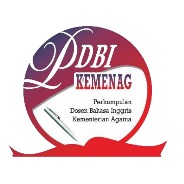Gamification in Duolingo App on Improving English Listening Proficiency of Junior High School Students
Abstract
Keywords
Full Text:
PDFReferences
Ajisoko, P. (2020). The use of Duolingo apps to improve English vocabulary learning. International Journal of Emerging Technologies in Learning (IJET), 15(7), 149–155.
Akbari, Z. (2015). Current challenges in teaching/learning English for EFL learners: The case of junior high school and high school. Procedia-Social and Behavioral Sciences, 199, 394–401.
Al-Azawi, R., Al-Faliti, F., & Al-Blushi, M. (2016). Educational gamification vs. game based learning: Comparative study. International Journal of Innovation, Management and Technology, 7(4), 132–136.
ANWAR, A. D. I. K. (2019). THE EFFECTIVENESS OF USING THIEVES AND CSR STRATEGIES TO IMPROVE THE READING COMPREHENSION OF GRADE 8 STUDENTS OF MTsN 2 JEPARA.
Bloomfield, J., & Fisher, M. J. (2019). Quantitative research design. Journal of the Australasian Rehabilitation Nurses Association, 22(2), 27–30.
Brian, I. P. F. C. K., Saputra, I. N. P. H., & Wedhanti, N. K. (2018). THE EFFECT OF TEACHING USING AUDIOVISUAL (VIDEO) MEDIA, ON SEVENTH GRADE STUDENTS’LISTENING COMPREHENSION AT SMP NEGERI 1 MENGWI ACADEMIC YEAR 2017/2018. Jurnal Pendidikan Bahasa Inggris Undiksha, 5(2).
Chen, S., Zhang, S., Qi, G. Y., & Yang, J. (2020). Games literacy for teacher education. Educational Technology & Society, 23(2), 77–92.
Dalle, J., Hadi, S., & Baharuddin, H. N. (2017). The development of interactive multimedia learning pyramid and prism for junior high school using macromedia authorware. The Turkish Online Journal of Educational Technology, 16(3), 714–721.
Dindar, M., Ren, L., & Järvenoja, H. (2021). An experimental study on the effects of gamified cooperation and competition on English vocabulary learning. British Journal of Educational Technology, 52(1), 142–159.
Gangaiamaran, R., & Pasupathi, M. (2017). Review on use of mobile apps for language learning. International Journal of Applied Engineering Research, 12(21), 11242–11251.
Gerald, B. (2018). A brief review of independent, dependent and one sample t-test. International Journal of Applied Mathematics and Theoretical Physics, 4(2), 50–54.
Gilakjani, A. P., & Sabouri, N. B. (2016). Learners’ Listening Comprehension Difficulties in English Language Learning: A Literature Review. English Language Teaching, 9(6), 123–133.
Gushendra, R. (2017). AN EXPERIMENTAL STUDY: IMPROVING STUDENTS’VOCABULARY MASTERY BY USING ENGLISH SONGS. Indonesian Journal of Integrated English Language Teaching, 3(1).
Hafifah, H. (2021). The Effectiveness of Duolingo in Improving Students’ Speaking Skill at Madrasah Aliyah Bilingual Batu School Year 2019/2020. Language-Edu, 10(3).
Hsieh, Y., & Huang, S. (2020). Using an E-book in the secondary English classroom: Effects on EFL reading and listening. Education and Information Technologies, 25(2), 1285–1301.
Huynh, D., Zuo, L., & Iida, H. (2016). Analyzing gamification of “Duolingo” with focus on its course structure. International Conference on Games and Learning Alliance, 268–277.
Jusuf, H. (2016). Penggunaan gamifikasi dalam proses pembelajaran. Jurnal TICom, 4(3), 92772.
Khaleel, F. L., Ashaari, N. S., & Wook, T. S. M. T. (2020). The impact of gamification on students learning engagement. International Journal of Electrical and Computer Engineering, 10(5), 4965.
Klemke, R., Eradze, M., & Antonaci, A. (2018). The flipped MOOC: using gamification and learning analytics in MOOC design—a conceptual approach. Education Sciences, 8(1), 25.
Le Boedec, K. (2016). Sensitivity and specificity of normality tests and consequences on reference interval accuracy at small sample size: a computer‐simulation study. Veterinary Clinical Pathology, 45(4), 648–656.
Lestari, S. (2018). Peran teknologi dalam pendidikan di era globalisasi. EDURELIGIA: Jurnal Pendidikan Agama Islam, 2(2), 94–100.
Liperote, K. A. (2006). Audiation for beginning instrumentalists: Listen, speak, read, write. Music Educators Journal, 93(1), 46–52.
Liu, M., & Yuan, R. (2021). Changes in and effects of foreign language classroom anxiety and listening anxiety on Chinese undergraduate students’ English proficiency in the COVID-19 context. Frontiers in Psychology, 12, 670824.
Loewen, S., Crowther, D., Isbell, D. R., Kim, K. M., Maloney, J., Miller, Z. F., & Rawal, H. (2019). Mobile-assisted language learning: A Duolingo case study. ReCALL, 31(3), 293–311.
Lu, K. (2020). Experimental research of English teaching management model based on personalized multimedia technology. Open Access Library Journal, 7(4), 1–13.
Maili, S. N., & Hestiningsih, W. (2017). Masalah-masalah pembelajaran Bahasa Inggris pada Sekolah dasar. Media Penelitian Pendidikan: Jurnal Penelitian Dalam Bidang Pendidikan Dan Pengajaran, 11(1).
Mubarak, A. Z. (2016). THE CURRICULUM 2013 DESIGN: ENGLISH TEACHERS’VOICE AND ITS IMPACT TOWARD TEACHING PROFESSIONALISM. SILIWANGI INTERNATIONAL ENGLISH CONFERENCE PROCEEDINGS “ENGAGING ENGLISH LEARNERS IN NEGOTIATED LANGUAGE LEARNING,” 12.
Nassaji, H. (2015). Qualitative and descriptive research: Data type versus data analysis. In Language teaching research (Vol. 19, Issue 2, pp. 129–132). Sage Publications Sage UK: London, England.
Niah, S. (2019). The Utilization of Duolingo to Improve the Speaking and Listening Skills of Junior High School Students in Pekanbaru. International Conference of CELSciTech 2019-Social Sciences and Humanities Track (ICCELST-SS 2019), 102–107.
Nurbainah, N., Hafifah, G. N., & Hesmatantya, V. (2017). THE EFFECTIVENESS OF DUOLINGO APPLICATION TO INCREASE STUDENT GRAMMAR ABILITY ON PERSONAL PRONOUN FOR SEVENTH GRADES OF TARUNA JAYA 1 JUNIOR HIGH SCHOOL SURABAYA. Universitas Muhammadiyah Surabaya.
Nushi, M., & Eqbali, M. H. (2017). Duolingo: A Mobile Application to Assist Second Language Learning. Teaching English with Technology, 17(1), 89–98.
Panjaitan, M. (2013). Analysis of Content Standards for English in Junior Secondary School and Senior Secondary School. Pusat Kurikulum Dan Perbukuan, 19, 140–155.
Perry, B. (2021). Gamified mobile collaborative location-based language learning. Frontiers in Education, 6, 689599.
Pinter, A. (2017). Teaching young language learners. Oxford University Press.
Purwanto, H. N., Faridi, A., & Rozi, F. (2022). The Effect of DuoLingo and SPADA to Teach Listening to Students with Different Achievement Levels. English Education Journal, 12(1), 86–94.
Romadhon, S. A., & Sungkar, M. S. (2020). Peningkatan vocabulary dan grammar dengan menggunakan metode Make a Match bagi siswa panti asuhan Putera Muslimat Brebes. JP3M: Jurnal Pendidikan, Pembelajaran Dan Pemberdayaan Masyarakat, 2(2), 175–180.
Rose, H., Curle, S., Aizawa, I., & Thompson, G. (2020). What drives success in English medium taught courses? The interplay between language proficiency, academic skills, and motivation. Studies in Higher Education, 45(11), 2149–2161.
Sari, B. W., Utami, E., & Al Fatta, H. (2015). Penerapan Konsep Gamification pada Pembelajaran Tenses Bahasa Inggris Berbasis Web. Sisfotenika, 5(2), 155–166.
Saxton, M. (2017). Child language: Acquisition and development. Sage.
Sharma, G. (2017). Pros and cons of different sampling techniques. International Journal of Applied Research, 3(7), 749–752.
Sidik, G. T., Kelana, J. B., Altaftazani, D. H., & Firdaus, A. R. (2020). The Effect of Macromedia Flash Based Learning Media To Improve the Ability To Calculate of Students in Elementary School. PrimaryEdu-Journal of Primary Education, 4 (2), 241.
Simmons, R. G., & Blyth, D. A. (2017). Moving into adolescence: The impact of pubertal change and school context. Routledge.
Su, F., & Zou, D. (2022). Learning English with the mobile language learning application’Duolingo’: the experiences of three working adults at different proficiency levels. International Journal of Mobile Learning and Organisation, 16(4), 409–428.
Sürücü, L., & MASLAKÇI, A. (2020). Validity and reliability in quantitative research. Business & Management Studies: An International Journal, 8(3), 2694–2726.
Teske, K. (2017). Duolingo. Calico Journal, 34(3), 393–401.
Wagner, E. (2020). Duolingo english test, revised version july 2019. Language Assessment Quarterly, 17(3), 300–315.
Waluyo, B., & Bucol, J. L. (2021). The impact of gamified vocabulary learning using Quizlet on low-proficiency students. Computer Assisted Language Learning Electronic Journal, 22(1), 164–185.
Wijaya, R. K., Yufrizal, H., & Kadaryanto, B. (2016). Improving vocabulary through Duolingo application in Call at the seventh grade of SMP. U-JET, 5(1).
Yana, D. (2021). Applying Duolingo as English Learning Media: How do Students Perceive it? INTERNATIONAL JOURNAL OF LANGUAGE PEDAGOGY, 1(2), 62–66.
Yordanova, Z. (2019). Gamification as a tool for supporting Artificial Intelligence development–State of Art. International Conference on Applied Technologies, 313–324.
Yulisa, D. (2018). Learning to listen: Listening strategies and listening comprehension of Islamic senior high school students. Edukasi: Jurnal Pendidikan Dan Pengajaran, 5(1), 22–30.
ZA, A. M. (2017). THE IMPLEMENTATION OF DUOLINGO AS MEDIA TO IMPROVE STUDENTS’ENGLISH LANGUAGE SKILL AT IAIN LANGSA. INSTITUT AGAMA ISLAM NEGERI LANGSA.
DOI: http://dx.doi.org/10.29240/ef.v7i1.5377
Refbacks
- There are currently no refbacks.
Copyright (c) 2023 Umniyah Juman Rosyidah

This work is licensed under a Creative Commons Attribution-NonCommercial-ShareAlike 4.0 International License.
INDEXED BY:
 This work is licensed under a Creative Commons Attribution-NonCommercial-ShareAlike 4.0 International License
This work is licensed under a Creative Commons Attribution-NonCommercial-ShareAlike 4.0 International License
@ ENGLISH FRANCA : Academic Journal of English Language and Education
Jl. Dr. AK Gani No 1 Dusun Curup, Rejang Lebong Regency, Bengkulu Province, Indonesia, 39119.
Dr. Eka Apriani, M.Pd., email: efranca@iaincurup.ac.id, eka.apriani@iaincurup.ac.id.




.png)












